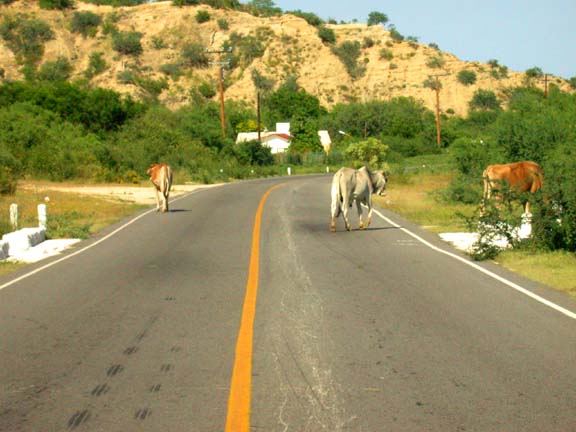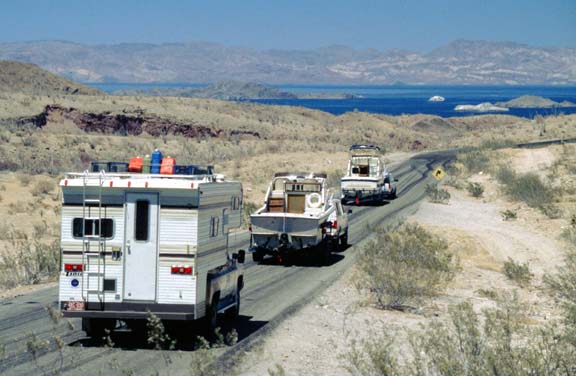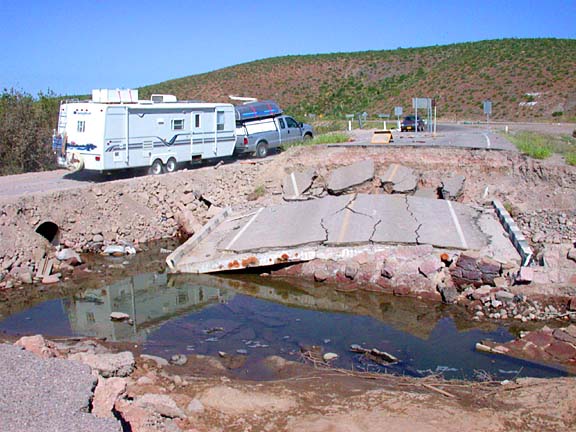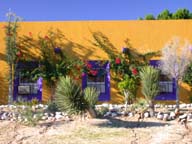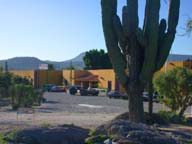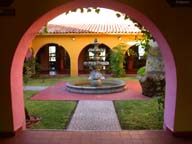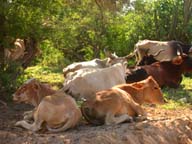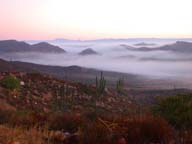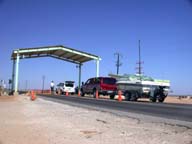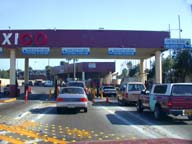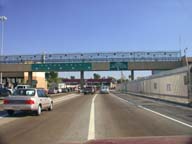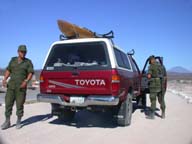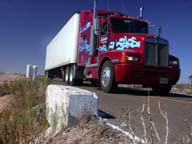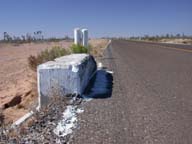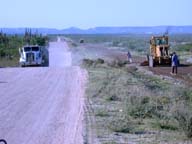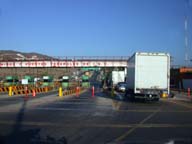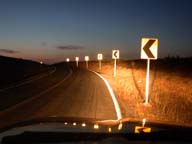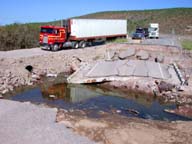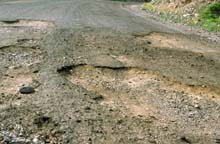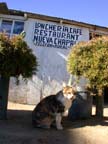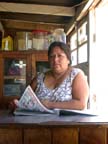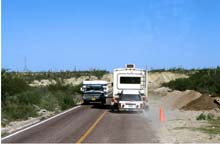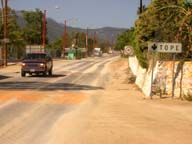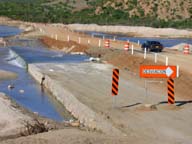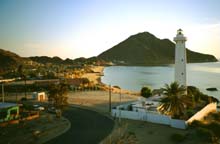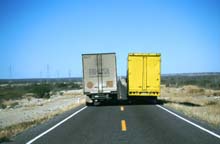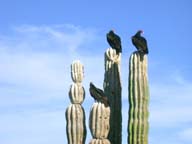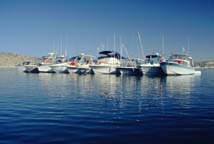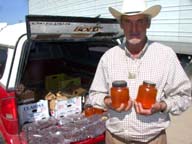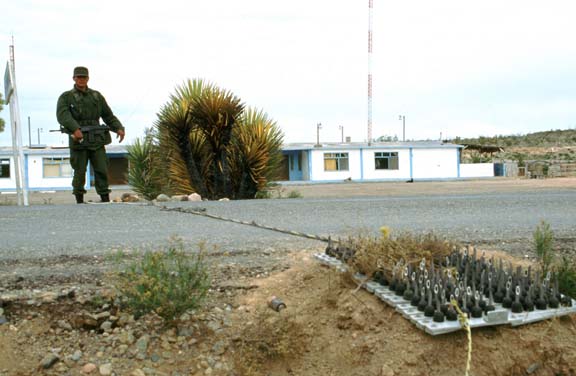
Trailering Your Boat to Baja
![]()
|
Your friends, the cows, on Baja California's Transpeninsular Highway. |
GETTING DOWN MEX 1 AND BAJA SIDE ROADS SAFETY WITH A WIDE, HEAVY LOAD
By Gene Kira, Nov. 11, 2001, as published in Western Outdoors Magazine:
With the general "civilization" of Baja's Transpeninsular Highway that has gradually occurred during the last ten years or so, trailering your boat to go fishing in Mexico's states of Baja California or Baja California Sur is no longer the hair-raising, white-knuckle, go-for-broke adventure it once was.
The most important factor in making this so has been the physical smoothing and upgrading of the road itself, along with what seems like a twenty-fold increase in the number of workers and vehicles dedicated to maintaining it.
|
|
On average, the blacktop surface of Mex 1--the 1,070-mile Transpeninsular Highway linking the U.S. border at Tijuana with Cabo San Lucas at the tip of Baja California--has, in effect, grown several inches in overall width during the last ten years, thanks mainly to improved shoulder maintenance and the quick repairs being made to broken edge asphalt. While this may not seem like a real big deal, for anyone towing an eight-foot-wide boat, those precious few inches truly make all the difference in the world.
A second important area of improvement in recent years is pothole repair. A typical, full-length run to Cabo San Lucas nowadays will encounter an average of fewer than 100 significant potholes in 1,070 miles of driving, a total hardly worth noting. But in past years, potholes seemed to multiply like rabbits during the rainy winter months, and they would go unrepaired until they grew and merged together into solid fields of connected craters that could extend for many miles. It would not be an exaggeration to estimate that at its very worst, Mex 1 in the old days could easily average a pothole every twenty feet over its entire length, creating a nightmarish boat trailer obstacle course of perhaps a quarter-million major potholes between Tijuana and Cabo San Lucas.
Guardrails, painted centerlines and edgelines, and reflective lane markers have also become common on Mex 1, making it much easier to "claim your territory" against oncoming traffic on the narrow roadbed. These improvements may not stop all oncoming drivers from crossing over the centerline, but at least when they do, it is clear who the guilty party is.
Despite all these recent improvements, trailering a boat down into Baja is still not a project to be taken lightly. The road is still probably the most hazardous that most tourists will ever encounter, and lack of complete preparation, or a moment's inattention, can lead to disaster.
|
The classic approach to Bahia de los Angeles. |
Here, in no particular order, are some helpful trailering tips and little insights gained over the course of several hundred-thousand miles of driving on Mex 1 and the major side roads of Baja. These tips are "Baja-specific," in that it is assumed that you've got all the basics (such as carrying spare wheel bearings, greasing your trailer ball, and crossing your safety chains under your hitch) already covered:
--Despite the recent road improvements, Mex 1 is still a physical challenge for your rig. If you're maxed out on gross weight, you will find yourself straining on long, steep grades, and sharp little drops and rises as you turn off the road or try to climb back on. You'll find the going much easier if your rig and its individual parts, such as trailer balls, are loaded to significantly less than their theoretical maximums.
--Be sure to have all necessary Mexican paperwork, including insurance, fishing licenses, and boat permits. Good information is available through the two main travel clubs, Discover Baja, telephone 800-727-2252; and Vagabundos del Mar, telephone 800-474-2252.
--When you stop for a break or for gas, do a quick walk-around of your rig, checking for loose parts and tie-downs, electrical connections, hitch problems (such as a loose ball), tire pressures, leaking fluids, lug nuts, and tire and wheel bearing temperatures (feel them with your hands). If you discover a problem that you can't fix yourself, excellent mechanics are available almost every inch of the way along Mex 1.
|
After a hurricane in Baja Sur. |
--Spare parts should include extra bulbs and wire, wheel bearings, shackle parts, a spare ball, and plenty of bailing wire and duct tape. Two spare trailer tires are no longer necessary, but make sure your primary spare is in good condition and properly inflated. Have a good jack and wooden blocks for working on soft dirt if necessary. Carry emergency reflective triangles to warn traffic, in case you can't get completely off the roadbed during repairs. Make sure you have a good flashlight with fresh batteries.
--The road will cause lots of vibration in your rig. Make sure all connections are tight and check them often. Use locknuts with nylon inserts to avoid loosening of trailer parts. Consider having your trailer ball nut tack welded to the mounting shaft to prevent it from loosening. Use extra tie-down straps and check them often. Nylon tie-down ropes will loosen as you drive through high humidity, fog or rain. Tighten if necessary. To prevent possibly spectacular damage, it is essential that your boat not bounce on its trailer bunkers. Use bungee cords to secure such things as trailer jacks, winch handles, and safety chains in their proper positions. Don't ever rely on the winch to hold the boat in position. Use bow and transom tie-downs.
--Speaking of vibration, here's a safety tip for plastic gasoline cans. Place them onto individual plastic kitty litter trays and fasten them in with bungee cords. Then secure the whole package in your rig. That way, it's almost impossible for vibration and bouncing to damage or overturn your cans--and heaven forbid--cause a gas leak.
--More on vibration. When you lower your tow vehicle tire pressures for increased flotation on sand, or a softer ride on washboard, remember to lower your trailer tire pressures as well. Contrary to popular belief, there is no single ideal pressure, such as 20 p.s.i., that is correct for off-pavement work. Depending on your load, tire size, and rims, your best pressure may be quite different. The proper method is to gradually lower pressure, and keep checking by pushing very hard, in and out, against your tire. When you see a "bueno" amount of flexing in your sidewalls, that's probably about the correct pressure for a soft ride and good flotation. Experience will teach you the proper pressure for your rig. The danger in going too low is that excessive sidewall flex will make you susceptible to rock or rim damage.
|
The Catavina La Pinta Hotel, a favorite rest stop for trailerboaters.
1.Our friends the cows. Due to increased traffic, they don't sleep on the road much anymore. 2. A beautiful dawn, climbing the hills south of El Rosario. 3.The immigration checkpoint at Guerrero Negro.
1. & 2. At the border. Cabo San Lucas, 1,070 miles ahead. 3. A routine army checkpoint on Mex 1. No problem.
1. & 2. These concrete culvert blocks are installed and maintained by the Baja California Trailer Axel Welders' Association (just kidding). Watch out especially when they are hidden by weeds. 3. Big paving crews now keep Mex 1 in top condition. |
--Cows sleeping on the road at night are no longer a significant hazard. They would if they could, but there's so much night traffic nowadays, a self-respecting cow just can't get in a decent night's sleep on Mex 1 any more. That's good news.
--However, there are still plenty of cows wandering around at night, and in the daytime too. Plus horses, goats, and other animals. One rule to keep in mind about herding animals is that they rarely travel alone. If a steer dashes across the road ahead of you and disappears into the bushes, this is no time to say "he's gone" and relax. There is probably another steer right behind it, perfectly timed to dash into your path just as you pass by. Give all herding animals enough space to include their invisible, lurking brethren.
--Watch out for Mexican vaqueros too. These guys make bullfighters look like whimps. The closest I've come to killing someone on Mex 1 was twice when horsemounted vaqueros dashed in front of my vehicle in wild pursuit of cows. Another time, I almost hit a pickup with a vaquero hanging out of the window trying to rope a running burro. (He lassoed it on the first throw, and then jumped out of the window of the still-moving pickup to bring it down.)
--Road hazards are fewer and fewer on Mex 1, but that makes the remaining ones all the more surprising and dangerous. It's easy to get lulled into a sense of security, and then get zapped by a sudden emergency you didn't expect. Relax and enjoy the easy driving stretches, but stay double alert to those nasty gremlins. They definitely will pop up when you least expect them. Watch out especially for eroded or undercut edge blacktop, concrete culvert blocks hidden in the weeds at the edge of the pavement, potholes or sinkholes, and sharp little drop-offs at the edge of the pavement. These can severely damage a boat trailer, or cause you to lose control.
--One type of road hazard that is actually increasing on Mex 1 is caused by things dropped by other vehicles. Watch out for lumber full of nails, agricultural products, metal parts, and other hazards. One of the most dangerous things I've seen spilled on Mex 1 was a full barrel of blacktopping oil that toppled over inside a truck on the notorious, cliff-hanging Santa Rosalia grade, "Cuesta del Infierno." The oil spread out on the bed of the moving truck, and spilled completely across the steep, uphill lane in a thin sheet. Perfect ice skating conditions! My pickup slowly came to a stop, with its rear tires still churning, and then slowly slid backwards, despite having the brakes completely locked up. Luckily, it came to a gentle stop against the inside of the turn. Coulda been a lot worse!
--Don't pay for gas or diesel fuel with dollars. You will often pay way too much because of the ridiculously unfavorable (for you) exchange rate offered. Pay in pesos.
|
1. The first leg of Mex 1 is the Ensenada toll road. 2. Pavement striping and increased signage make night driving on Mex 1 easier for those who chose to risk it. 3. Easy does it. Most washouts, large and small, are quickly repaired nowadays.
1. An old photo. Potholes like this used to be common, but are becoming hard to find. 2. Rancho Laguna Chapala, a traditional stopping point on Mex 1. Try the fish machaca burritos. 3. Senora Hortensia Duarte de Grosso of Rancho Laguna Chapala, a venerable and traditional stop on Mex 1.
1. An RV hits the dirt during a tight squeeze on Mex 1. Sharp edge drop-offs can make this kind of excursion expensive. 2.San Bartolo, a few miles north of East Cape, is the "tope" or speed bump capital of Mex 1. Eight bumps in town. 3. A big washout south of Todos Santos caused by Hurricane Juliette. |
--Here's a simple but very handy tip that can increase safety significantly. Carry your own squeegee for cleaning your windshield, since these are rarely available at Pemex stations. Baja can be buggy, and you will be safer if you can see properly, especially at night. Sometimes, in agricultural areas, you'll drive through a swarm of bugs that can completely blind you, and you must stop to clean your windshield. Having a squeegee along makes it more likely that you will do so immediately.
--When driving at night, don't resent it if you always seem to be the first one to lower your headlight beams for oncoming traffic. It is a widely-known fact that a Mexican male's genitalia will immediately fall off, if he is ever the first one to lower his headlight beams. You should lower your beams first for him, in the interest of the preservation of La Raza. In practice, there are a significant number of cars that cannot lower their high-beams, for the simple reason that they have no low-beams. For them, it's high-beam or nothing, which would be bad for everyone involved. When driving Mex 1 at night, you should be psychologically prepared at all times to slow, or even pull over and stop your car if necessary to let these or other super-bright vehicles pass by.
--When in doubt, never hesitate to reduce speed to what feels safe to you. It is easy to let yourself get "hypnotized" into thinking that you must maintain a certain average speed. Ridiculous! Especially when towing a boat, there will be many, many places where you must slow way down to be safe, to avoid letting your trailer cross the centerline, or to avoid having it go off the edge of the blacktop. Relax and enjoy the ride. Allow at least three full days of driving to reach Cabo San Lucas. Yes, you can push it through in less time, but only at great risk. The road seems to grow about one foot in width for every ten miles-per-hour that you slow down. Try it, put on some good music, and enjoy your trip.
--Today, there are many more military checkpoints on Mex 1 than in the past. These are mostly looking for guns and drugs. Americans naturally bristle at any form of police search without plenty of just cause. It's a constitutional thing, deeply ingrained in our national psyche. However, these Baja checkpoints are not to be feared or resented. Most of the young army troops manning them are from the interior of Mexico. They are universally respectful, and sincerely curious about foreigners, whom they find very interesting. A cooperative attitude and respectful approach will make these checks quick and painless. I've been through hundreds of them with nary a problem, although I certainly do always make sure to keep cash and valuables with me as I go to the rear of my rig to open the tailgate and let them do their search (human nature is human nature, right?).
|
1. A beautiful dawn at San Felipe, northernmost trailer boat destination on the Sea of Cortez. 2. Despite recent improvements, Mex 1 is still a tight squeeze. 3. Hungry vultures waiting patiently for someone to have an accident.
1. A Vagabundos del Mar trailer boat raft-up at Caleta San Francisquito in the Midriff Area. 2. Alfredo Ninsunsa, 77, has been selling his honey, dates, and exotic fruits at the Pemex station at Vizcaino for many years. |
Incidentally, if you speak no Spanish, you may be interested to know that when they stop you, they almost always ask the same two questions: "Where are you coming from?" and "Where are you going?" Why they ask this is a mystery, since you are obviously free to make up any story you wish. However, if you give them any halfway realistic answer, they will be immediately satisfied. They may also ask if you are carrying any drugs or guns. So far, I've never had the cojones to answer "Sí," just to see what would happen. (For these situations, it's a good idea to learn Spanish, at least enough to get by.)
|
|
Once, I was carrying a small pocket knife, beautifully handmade by a Mexican ranchero to look just like a little revolver when the blade was folded up. At one of these checkpoints, my newly-purchased souvenir touched off a wild celebration (and probable dreams of an instant field promotion) when one of the troops found it in the glove compartment, and he went running off to the headquarters tent to show it to his commander. I was immediately surrounded by a cordon of soldiers giving me hard looks. A few minutes later, the trooper with the pocket knife returned and handed it back to me. That was the saddest, most miserable-looking soldier I've ever laid eyes on, and his buddies made the most of it.
--Mordida is alive and well in Baja, and it, also, should not be taken personally. As experienced by tourists, this "little bite" is the small bribe that is paid in the street to a traffic cop in order to settle a minor violation--real or imagined--on the spot.
Some Baja tourists get indignant when mordida is requested, and they demand to be taken to the police station where they will presumably duke it out with the Mexican legal system and prevent the cop from cashing in on his corrupt activities. This is silly. The cop will get his share anyway, for bringing you in. Moreover, since the mordida must now be split several ways, you will undoubtedly have to pay more in order to make it worthwhile for all the people that you have unwittingly involved in the plot.
It is much simpler, to smile and negotiate. The cop will typically start off with somewhere between 400 and 1,000 pesos. Don't let the initial amount rattle you, or get mad or disrespectful. This is merely a hopeful opening point for negotiations (amazingly to the cop, sometimes tourists will simply pay the initial asking price). Just be pleasant and explain that you don't have that much cash. He will then ask you how much you can afford. About 100 pesos ($11) will satisfy him as an honorable amount. He will give you a piece of paper, into which you will fold the money in your lap, so the transaction cannot be seen by passing citizens (mordida, of course, does not officially exist in Mexico). You hand him the paper, and you're on your way. Was the traffic violation legitimate, or concocted? Really, amigo, that is not the point!
|
A long rope can quickly pull this kind of spike board across your path in case you decide to "run" a checkpoint on Mex 1. |
(Related Baja California, Mexico, articles and reports may be found at Mexfish.com's main Baja California information page. See weekly fishing news, photos, and reports from the major sportfishing vacation areas of Mexico including the Baja California area in "Mexico Fishing News.")
MEXICO FISHING INFO BAJA FISHING INFO "WEEKLY MEXICO FISHING NEWS" FISH PHOTO GALLERY
